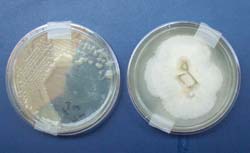UC Riverside scientists isolate microorganisms that break down a toxic pesticide

Isolated purified bacterial (left) and fungal (right) strains decomposing endosulfan. (Photo credit: Judy Chappell.) <br>
Research is key step in detoxifying endosulfan toward improving soil and water quality
Scientists at the University of California, Riverside report in the Journal of Environmental Quality (JEQ) that they have isolated microorganisms capable of degrading endosulfan, a chlorinated insecticide widely used all over the world and which is currently registered to control insects and mites on 60 U.S. crops. JEQ, established in 1972, is published jointly by the American Society of Agronomy, Crop Science Society of America, and the Soil Science Society of America.
Bioremediation of contaminated sites and water bodies by using these microbial strains will provide an environment free of endosulfan toxicity, the researchers argue in their paper. The research stands to benefit the agrochemical industry and environmental agencies involved in remediation of soil and water contaminated with organochlorine pesticides. Currently, bioremediation is considered the most cost-effective technology to remediate contaminants, including pesticides. The usefulness of the new technology may be best measured economically in soil and water quality impacted by pesticide spillage, overdosing, and cleanup of agrochemical equipment.
Many health hazards are associated with endosulfan. Endosulfan is a persistent organic pollutant or “POP” that enters the air, water, and soil during its use and manufacture. Owing to the persistence in the environment, residues of endosulfan can enter the food chain and directly affect public health. Endosulfan’s residues have also been found in sediments and in surface and ground waters. Endosulfan affects the central nervous system, kidney, liver, blood chemistry and parathyroid gland and has reproductive, teratogenic (causing birth defects) and mutagenic (causing genes to mutate more frequently) effects.
“We have been successful in isolating strains that can use endosulfan as a carbon and energy source,” said William Frankenberger, director of the UCR Center for Technology Development and professor of soil science and soil microbiologist at UC Riverside. “Pollutants are rapidly degraded by microorganisms when used as a carbon and energy source. Out of 10 microorganisms isolated and screened for their degradative capabilities towards endosulfan degradation, the strains we isolated – Fusarium ventricosum and Pandoraea sp. – degraded about 90% and 83% of 100 ppm endosulfan, respectively, in 15 days using the pesticide as a carbon and energy source. Other bacterial strains that we isolated using endosulfan as a sulfur source could degrade about 70% endosulfan.”
Total average annual use of endosulfan is estimated at approximately 1.38 million pounds of active ingredient. Classified as an organochlorine (the same family of pesticide as DDT and dieldrin), endosulfan and its breakdown products are persistent in the environment with an estimated half-life of 9 months to 6 years. It is one of the most commonly detected pesticides in U.S. water (38 states).
“In isolating these microbial strains, various environmental samples were collected from different sites,” said Frankenberger, who is one of the co-authors of the JEQ paper. “Enrichment techniques were used to isolate microbial strains which were capable of degrading endosulfan. The isolated microorganisms were intensively screened for their degradative capabilities towards endosulfan degradation, purified and identified by molecular tools.”
The results of the study suggest that these strains are a valuable source of endosulfan-degrading enzymes and may be used for the detoxification of endosulfan in contaminated soils, wastedumps and water bodies, as well as agricultural dealership sites, waste water from recycling plants and unused or expired stockpiles of endosulfan.
This research was conducted in the Department of Environmental Sciences at UC Riverside during 2001-2002. The department offers B.S. and B.A. degrees in Environmental Sciences, and M.S. and Ph.D. degrees in Soil and Water Sciences. The department is part of the College of Natural and Agricultural Sciences. The forerunner of the department was an agricultural chemistry research unit in the world-renowned California Citrus Research Center and Agricultural Experiment Station established in Riverside in 1907.
Media Contact
More Information:
http://www.newsroom.ucr.edu/cgi-bin/display.cgi?id=535All latest news from the category: Life Sciences and Chemistry
Articles and reports from the Life Sciences and chemistry area deal with applied and basic research into modern biology, chemistry and human medicine.
Valuable information can be found on a range of life sciences fields including bacteriology, biochemistry, bionics, bioinformatics, biophysics, biotechnology, genetics, geobotany, human biology, marine biology, microbiology, molecular biology, cellular biology, zoology, bioinorganic chemistry, microchemistry and environmental chemistry.
Newest articles

First-of-its-kind study uses remote sensing to monitor plastic debris in rivers and lakes
Remote sensing creates a cost-effective solution to monitoring plastic pollution. A first-of-its-kind study from researchers at the University of Minnesota Twin Cities shows how remote sensing can help monitor and…

Laser-based artificial neuron mimics nerve cell functions at lightning speed
With a processing speed a billion times faster than nature, chip-based laser neuron could help advance AI tasks such as pattern recognition and sequence prediction. Researchers have developed a laser-based…

Optimising the processing of plastic waste
Just one look in the yellow bin reveals a colourful jumble of different types of plastic. However, the purer and more uniform plastic waste is, the easier it is to…



